*NURSING > EXAM > NR 511 Complete Midterm Study Guide worksheet (Updated 300+ Pages) | NR 511 Complete Midterm Study G (All)
NR 511 Complete Midterm Study Guide worksheet (Updated 300+ Pages) | NR 511 Complete Midterm Study Guide worksheet (Updated 300+ Pages)
Document Content and Description Below
NR 511 Complete Midterm Study Guide worksheet (Updated 300+ Pages) Disease Risk Subjective Finding Objective Findings Diagnostics Treatment Education GI DISORDERS Appendicitis -Most common between ... 10-30yrs; but can occur at any age; rare in infants and older adults -men more at risk - Diets low in fiber, high in fat, refined sugars, & other carbs at increased risk. - Obstruction of appendix is cause of majority of appendicitis - contributing factors: Intra-abdominal tumors, positive family hx - Recent roundworm infection or viral GI infection -Dx made clinically, based primarily on H&P exam - Classic presentation includes acute onset of mild to severe colicky, epigastric, or periumbilical pain - Pain is vague at first then localizes within 24hrs to RLQ - Pain exacerbated by walking\coughing - Men may feel radiated pain in testes - Abd muscle rigidity, N\V, anorexia - Mildly elevated temp 99-100F common - If RLQ accompanied by shaking chills, perforation should be suspected - Older adults may present with weakness, anorexia, abd distention, mild pain leading to delayed dx and increased morbidity. -May have HTN\tachy proportional to pain\ symptoms -When lying flat, may flex R knee to relieve tension in abd muscle -Pain with palpation in abd, diffuse in early stages. Localized to RLQ later -Positive for rebound pain; ask pt to cough to localize pain location -Sudden cessation of pain means perforation and is ER -Labs are not diagnostic and nonspecific -Women should have urine human chorionic gonadotrophin to r\o ectopic pregnancy - +Rovsing’s Sign- deep palpation & release in LLQ causes rebound pain in RLQ - +Psoas Sign- lift R leg against gentle pressure causes pain - +Obturator Sign- flex R hip & knee and slowly rotate internally causes pain - +McBurney’s Sign- pain with pressure applied to point between umbilicus & ilium - x-ray\CT helpful when paired with positive H&P findings -Surgical; preoperative care, NPO, correction of fluid\electrolyte imbalances -Avoid narcotics -Atb with 3rd gen cephalosporin; Ex: ampicillin, gentamycin, flagyl -F\U with surgeon -Ambulation after surgery -Adv diet when bowel sounds return -Return to hosp with s\s of infection -Avoid heavy lifting for at least 2 wks Celiac disease ** (autoimmune disorder caused by an immunologic response to gluten) Mostly diagnosed in adulthood. A family member with celiac disease or dermatitis herpetiformis Type 1 diabetes Many asymptomatic. May complain of diarrhea, gas, dyspepsia, wt loss. Atypical symptoms: fatigue, bone or joint pain, arthritis, osteoporosis, or Muscle wasting (anemia), reduces subcutaneous fat, ataxia, & peripheral neuropathy (vitamin B12 deficiencies) osteoporosis or osteopenia (bone loss) Serologic testing for anti-tTG IgA antibody Total IgA (2% of pts have IgA deficiency and will falsely test negative) duodenal biopsies lifelong adherence to a strict gluten-free diet. Referral to a dietician to help. Some pts may need treatment with immunomodulating teaching related to gluten free diet. Some people with celiac disease have vitamin or nutrient deficiencies that do not cause them to feel ill, such as anemia due to iron NR511 Midterm Study Guide Worksheet Down syndrome or Turner syndrome Autoimmune thyroid disease Microscopic colitis (lymphocytic or collagenous colitis) Addison's disease osteopenia (bone loss) liver and biliary tract disorders (transaminitis, fatty liver, primary sclerosing cholangitis, depression or anxiety peripheral neuropathy seizures or migraines missed menstrual periods infertility or recurrent miscarriage canker sores inside the mouth dermatitis herpetiformis (itchy skin rash) hypothyroidism Pts with dermatitis herpetiformis found to have signs of celiac disease on intestinal biopsy. Test for nutritional deficiencies associated with malabsorption of C.D. (hemoglobin, iron, folate, vit B12, Calcium, and Vitamin D.) agents. deficiency or bone loss due to vitamin D deficiency. However, these deficiencies can cause problems over the long term. Untreated celiac/developing certain types of gastrointestinal cancer. This risk can be reduced by eating a gluten-free diet. Cholelithiasis is the formation of gallstones and is found in 90% of patients with cholecystitis. --Risk factors--2 types of stones (cholesterol and pigmented) a. Cholesterol (most common form): female, obesity, pregnancy, increased age, drug- induced (oral contraceptives and clofibrates: cholesterol lowering agent), cystic fibrosis, rapid weight loss, spinal cord injury, Ileal disease with extensive resection, Diabetes mellitus, sickle cell anemia. b. Pigmented: hemolytic diseases, increasing age, hyperalimentation Patient complaint of indigestion, nausea, vomiting (after consuming meal high in fat), and pain in RUG or epigastrium that may radiate to the middle of the back, infrascapular area or right shoulder. Right side involuntary guarding of abdominal muscles, Positive Murphy's sign, possible palpable gallbladder, Low grade fever between 99-101 degrees. Possible jaundice from common bile duct edema and diminished bowel sounds. Mild elevation of WBC up to 15, 000 Abdominal Xray: Quick, noninvasive, reliable, and cost- effective means of identifying the presence of cholelithiasis. a. Initial management-- begins with definitive diagnosis. When asymptomatic (normally an incidental finding while exploring another problem) require no further treatment except teaching s/sx of "gallbladder attack". Nonsurgical candidate can be treated with dissolution therapy or lithotripsy. Acute includes hydration (IV fluids), antibiotics, analgesics, GI rest. b. Treatment of choice for Acute cholecystitis is early surgical intervention after stabilization. Poor surgical risk may benefit from cholecystectomy operatively or percutaneously. Nonsurgical intervention: weight loss, avoidance of fatty foods to decrease attacks, alternative birth control for persons taking oral contraceptives, menopausal women taking estrogen informed about alternative sources of phytoestrogens (soy products). NR511 Midterm Study Guide Worksheet (artificial supply of nutrients, typically IV), cirrhosis, biliary stasis, chronic biliary infections. Crohn’s ** Ages 15-25 of onset and Mild-Four or fewer Tenderness in LLQ or Stool analysis to r/o Glucocorticoids, there is Pt educated on then again at 50-80. loose bowel across entire abd with bacterial, fungal, or no cure for CD and disease process, Familial tendency, movements per day, guarding and abd parasitic infection for treatment is aimed at diet and lifestyle smoker can have small distension. DRE cause of diarrhea. suppressing inflammation changes. Stress Carcinoma less common amounts of blood and performed to look for CBC to check for and symptomatic relief of reduction, adequate in patients with CD due mucus in the stool, anal and perianal anemia, eval for complications. Initially rest to decrease to treatment and cramping in the inflammation, rectal hypocalcemia, vit D oral prednisone 40-60 mg/ bowel motility and sometimes colectomy rectum. Moderate-4-6 tenderness, and blood deficiency., d, tapered over 2-4 promote healing. loose bowel in stool. S/Sx of hypoalbuminemia, months, then can have Low residue diet movements per day peritonitis and ileus and steatorrhea. LFT daily maintenance dose of when obstructive sx containing more blood may be found to screen for primary 5-10mg/d. Sulfasalazine present such as and mucus and other depending on severity sclerosis cholangitis, for mild to moderate CD canned fruits, sx such as tachycardia, of crohns. Tender and other liver 500 mg BID, increased to vegetables and weight loss, fever, mild mass in RLQ, anal problems assoc with 3-4 g/d. Clinical white bread edema. Severe- fissure, perianal IBD. Check fluid and improvement in 3-4 wks, frequent bloody bowel fissure, edematous electrolytes. May and then tapered to 2-3 g/ movements (6-10), pale skin tags. Extra have elevated WBC d for 3-6 months, this abd pain and intestinal finding may count and sed rate medication interferes with tenderness, sx of be episcleritis, and prolonged folid acid absorption and anemia, hypovolemia, erythema nodosum, prothrombin time. patient must take impaired nutrition. nondeforming Barium upper GI supplements. Most common sx are peripheral arthritis, series, colonoscopy, Metronidazole effective in abd and axial arthropathy and CT to determine tx perianal disease and in cramping/tenderness, bowel wall thickening controlling crohns colitis, fever, anorexia, wt or abscess formation other ABT’s such as Cipro, loss, spasm, flatulence, Ampicillin, and RLQ pain or mass Tetracycline effective in controlling CD ileitis, and ileocolitis. Immunosuppressive meds when unresponsive to other treatments. Diverticulitis ** -Uncommon under -25% develop -LLQ abd tenderness -Abd x-ray can reveal -Asymptomatic cases -Increase fiber in 40yrs; risk rises after symptoms with possible Firm, free air, ileus, managed with high fiber diet to avoid -Rare in pediatric; equal -LLQ abd pain, worsens fixed mass may be obstruction diet or fiber supplement constipation and in men\women after eating identified in area of -Barium studies show with psyllium straining -More common in -Pain sometimes diverticula sinus tracts, fistulas, -Mild symptoms managed -H2O intake of at - - - - - - - - - - - - - - - - - - - - - - - - - - - - - - - - - - - - - NR511 Midterm Study Guide Worksheet 120 lb. Question 15. Martha, age 82, has an asymptomatic carotid bruit on the left side. What do you recommend? No treatment at this time. Question 16. When performing a sports physical exam on Kevin, a healthy 16-year-old boy, which question in the history is important to ask Kevin or his guardian? Did anyone in your family ever have sudden cardiac death? Question 17. If a screening test used on 100 individuals known to be free of breast cancer identified 80 individuals who did not have breast cancer while missing 20 of the individuals, the specificity would be: 80%. Question 18. Harvey, age 55, comes to the office with a blood pressure (BP) of 144/96 mm Hg. He states that he did not know if it was ever elevated before. When you retake his blood pressure at the end of the examination, it remains 144/96. What should your next action be? Try nonpharmacological methods and have him monitor his blood pressure at home. Question 19. Mimi, age 52, asks why she should perform a monthly breast self-examination (BSE) when she has her mammograms on schedule. You respond: “More than 90% of all breast abnormalities are first detected by self-examination.” Question 20. Which of the following individuals should get the shingles (herpes zoster) vaccine? Joe, who has a stressful job. Question 3. As a primary care provider, which of the following topics is not typically important for adults aged 20 to 40? Focusing on increasing lifespan Question 4. As a nurse practitioner, which of the following would not be an example of primary health promotion? NR511 Midterm Study Guide Worksheet Posting health articles on your social media account. Question 5. Which of the following initiatives does not fall under the National Prevention Strategy? Diabetes management. Question 7. The OLD CARTS (onset, location, duration, character, aggravating/alleviating factors, radiation, timing, severity) mnemonic is best used in which part of your chart note? History of present illness. Question 8. A nurse practitioner is practicing based on the rule-based actions he was taught in school and doesn’t understand when/where those rules may be inappropriate. Which following statement best describes this skill level? Novice. Question 9. Mildred, an independent 92-year-old woman, is moving into her daughter’s home. Her daughter comes to see you seeking information to help keep her mother from falling. Which of the following interventions would you suggest she do to help prevent Mildred from falling? Remove all loose rugs from floors and install hand grasps in bathtubs and near toilets. Question 10. Joseph, a 55-year-old man with diabetes, is at your office for his diabetes follow-up. On examining his feet with monofilament, you discover that he has developed decreased sensation in both feet. There are no open areas or signs of infection on his feet. What health teaching should Joseph receive today regarding the care of his feet? “See a podiatrist yearly; wash your feet daily with warm, soapy water and towel dry between the toes; inspect your feet daily for any lesions; and apply lotion to any dry areas.” NR511 Midterm Study Guide Worksheet Question 11. Sandra, a 27-year-old nurse, states that she does not want to get the hepatitis B virus vaccine because of its adverse effects. You tell her that the most common adverse effect is: Pain at the injection site. Question 12. Harry is taking his entire family to Central America and is wondering about protection against bites from malaria-causing mosquitoes. What advice do you give him? Use an insect repellent with diethyltoluamide (DEET) for adults and permethrin for children, and stay inside from dusk to dawn. Question 14. Susie, age 5, comes to the clinic for a well-child visit. She has not been in since she was 2. Her immunizations are up to date. What immunizations would you give her today? Diphtheria, tetanus, and pertussis (DTaP); inactivated polio vaccine (IPV); and measles, mumps, and rubella (MMR). Question 15. Mary, a 70-year-old woman with diabetes, is at your office for her 3-month diabetic checkup. Mary’s list of medications includes metformin (Glucophage XR) 1000 mg daily, an angiotensin-converting enzyme (ACE) inhibitor daily, and 1 baby aspirin (ASA) daily. Mary’s blood work showed a fasting blood sugar (FBS) of 112 and glycosylated hemoglobin (HbA1c) of 6.5. You tell Mary that her blood work shows: That her diabetes is under good control and she should remain on the same medications Question 16. Sandy, a 68-year-old woman, presents to your office for screening for osteoporosis. She states that her grandmother and mother both lost inches in their old age. She has been postmenopausal for the past 15 years and never took any hormone replacement medications. She is Caucasian, weighs 108 lb, and is 5 ft 1 in tall on today’s measurement. When do women lose the greatest amount of bone density? The first 10 years after menopause. Question 18. Julia, age 18, asks you how many calories of fat she is eating when 1 serving has 3 g of fat. You tell her: NR511 Midterm Study Guide Worksheet 27 cal. Question 19. Marian’s husband, Stu, age 72, has temporal arteritis. She tells you that his physician wants to perform a biopsy of the temporal artery. She asks if there is a less invasive diagnostic test. What test do you tell her is less invasive? Color duplex ultrasonography. Question 20. For which patient would you administer the human papillomavirus (HPV) vaccination? Janice, age 17, who had a baby 6 months ago and is breastfeeding. Question 1. Which of the following demonstrates a subjective finding? Pain level. Question 3. Which of the following statements about health promotion is false? Health promotion is a benefit to add to your practice if you have time. Question 4. Which of the following statements defines health literacy? The level to which a patient can understand, gain access to, and make proper medical decisions. Question 5. The study of the way diseases are spread through groups and what causes and helps spread these diseases is called? Epidemiology. Question 6. Which of the following statements does not belong in the past medical history portion of your chart note? NR511 Midterm Study Guide Worksheet Your patient had lab work at their last appointment that was negative. Question 7. An 81-year-old patient presents for a physical. She recently had a fall and now has problems walking up her stairs. The only restroom in the house is on the second floor. She also has a flight of stairs outside her house she has to navigate in order to reach street level, and this is difficult for her. Where does this information belong in your chart note? Functional health patterns. Question 10. Mark, a 56-year-old man, comes to your practice seeking help quitting smoking. You prescribe varenicline (Chantix), a prescription medication, to aid with his attempt. What instructions do you give Mark regarding how to stop smoking with Chantix? Start the Chantix today according to the dosing schedule and then pick a date to stop smoking about 7 days after starting Chantix. Question 11. How do you respond when Jill, age 42, asks you how long she should work out each week? Exercise for at least 30 minutes 5 days per week. Question 12. Marvin is a gay man who is ready to “come out.” What is the last step in the process of coming out? Identity integration and self-disclosure. Question 16. Jan’s mother has Alzheimer disease (AD). Jan tells you that her mother’s recent memory is poor and that she is easily disoriented, incorrectly identifies people, and is lethargic. Jan asks you, “Is this as bad as it gets?” You tell her that her mother is in which stage of the disease? Stage 3. Question 17. Herbert, a 69-year-old man, comes to your office complaining of nocturia. On questioning Herbert, you find that for the past 3 months he has been getting up at least 5 times a night to void. He came in to seek help today NR511 Midterm Study Guide Worksheet because of his wife’s insistence that he be checked out. When you perform the digital rectal exam, you find that his prostate protrudes 3 to 4 cm into the rectum. What grade would you assign to Herbert’s prostate enlargement? Grade 3 [Show More]
Last updated: 1 year ago
Preview 1 out of 322 pages
.png)
Buy this document to get the full access instantly
Instant Download Access after purchase
Add to cartInstant download
We Accept:

Reviews( 0 )
$16.50
Document information
Connected school, study & course
About the document
Uploaded On
Sep 13, 2020
Number of pages
322
Written in
Additional information
This document has been written for:
Uploaded
Sep 13, 2020
Downloads
0
Views
128














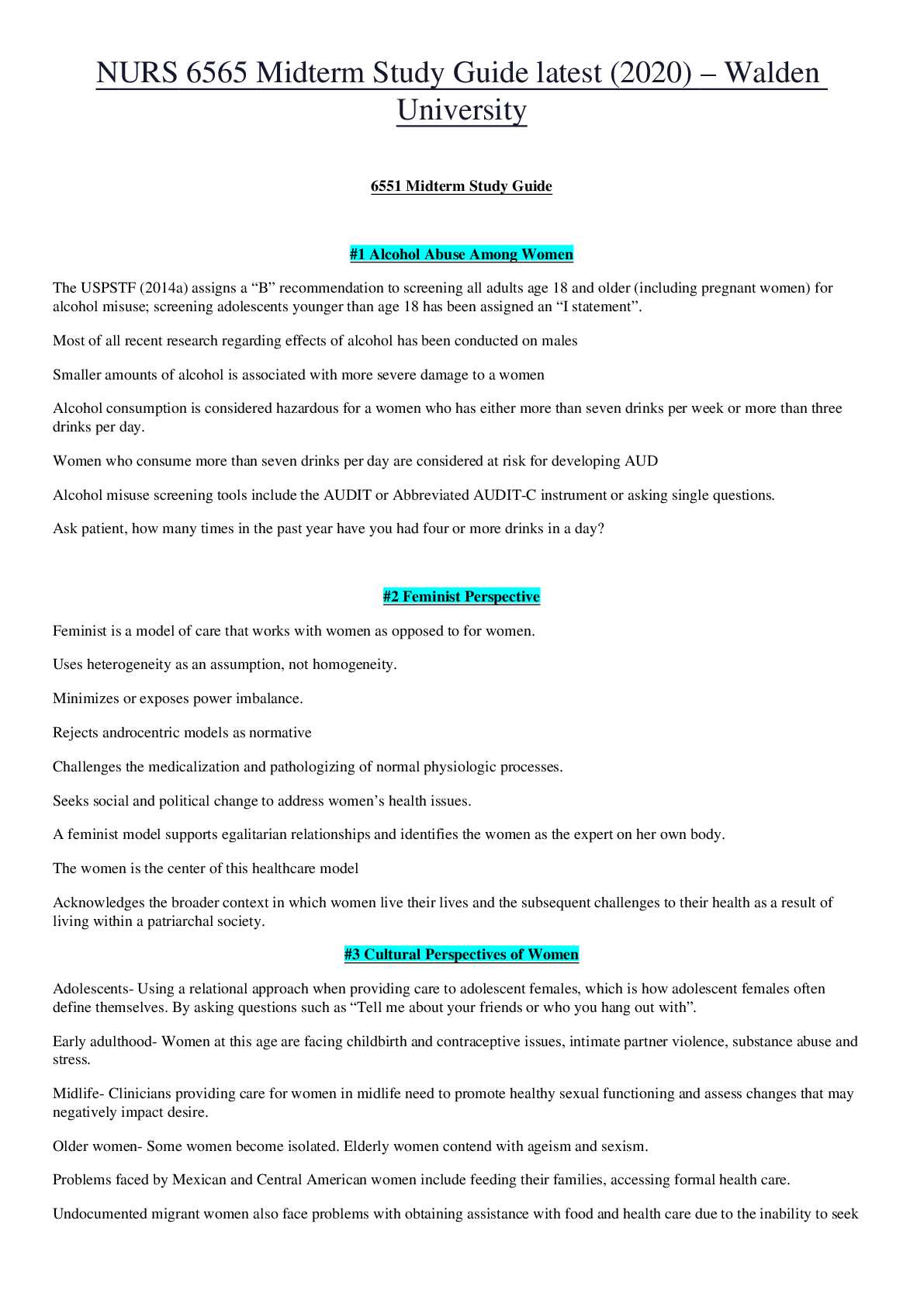
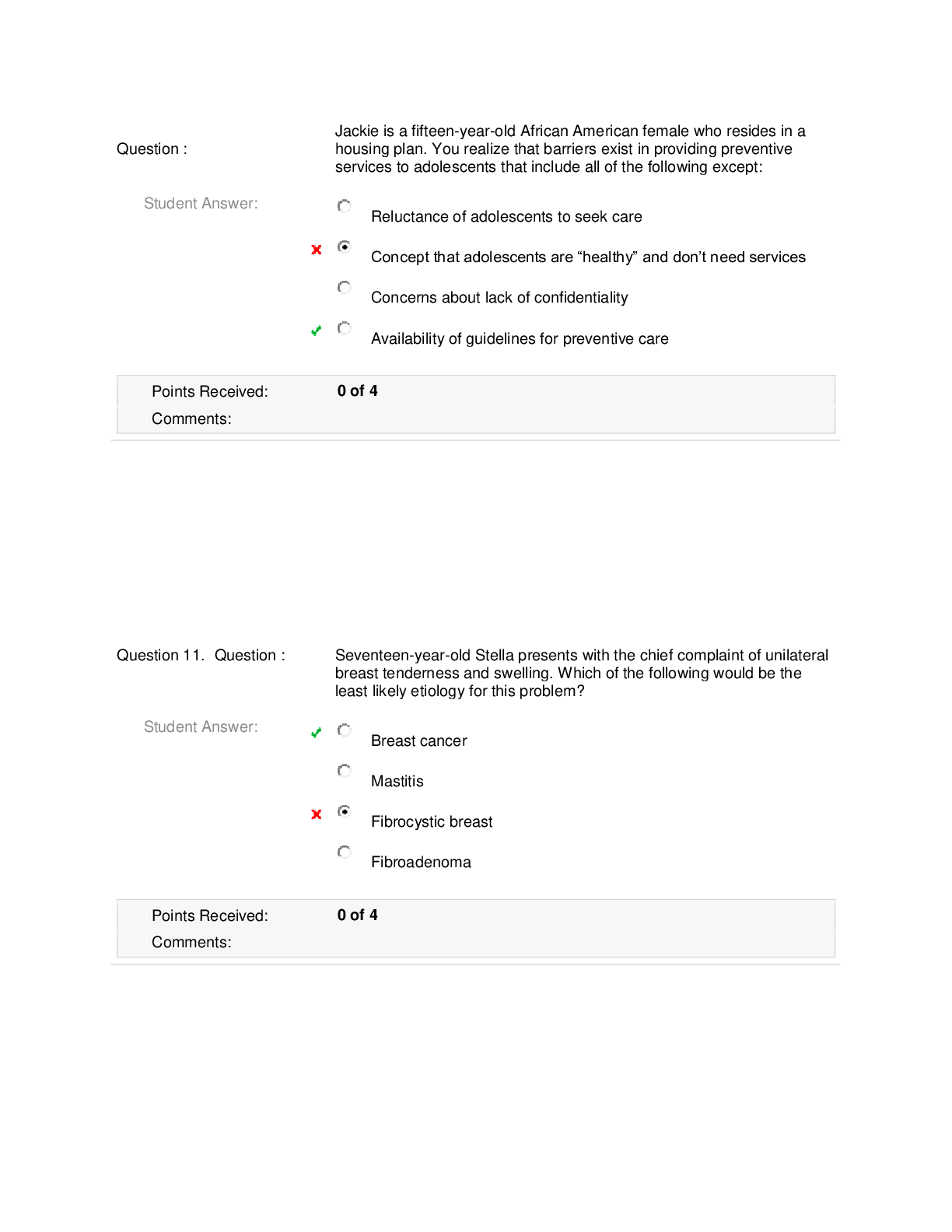
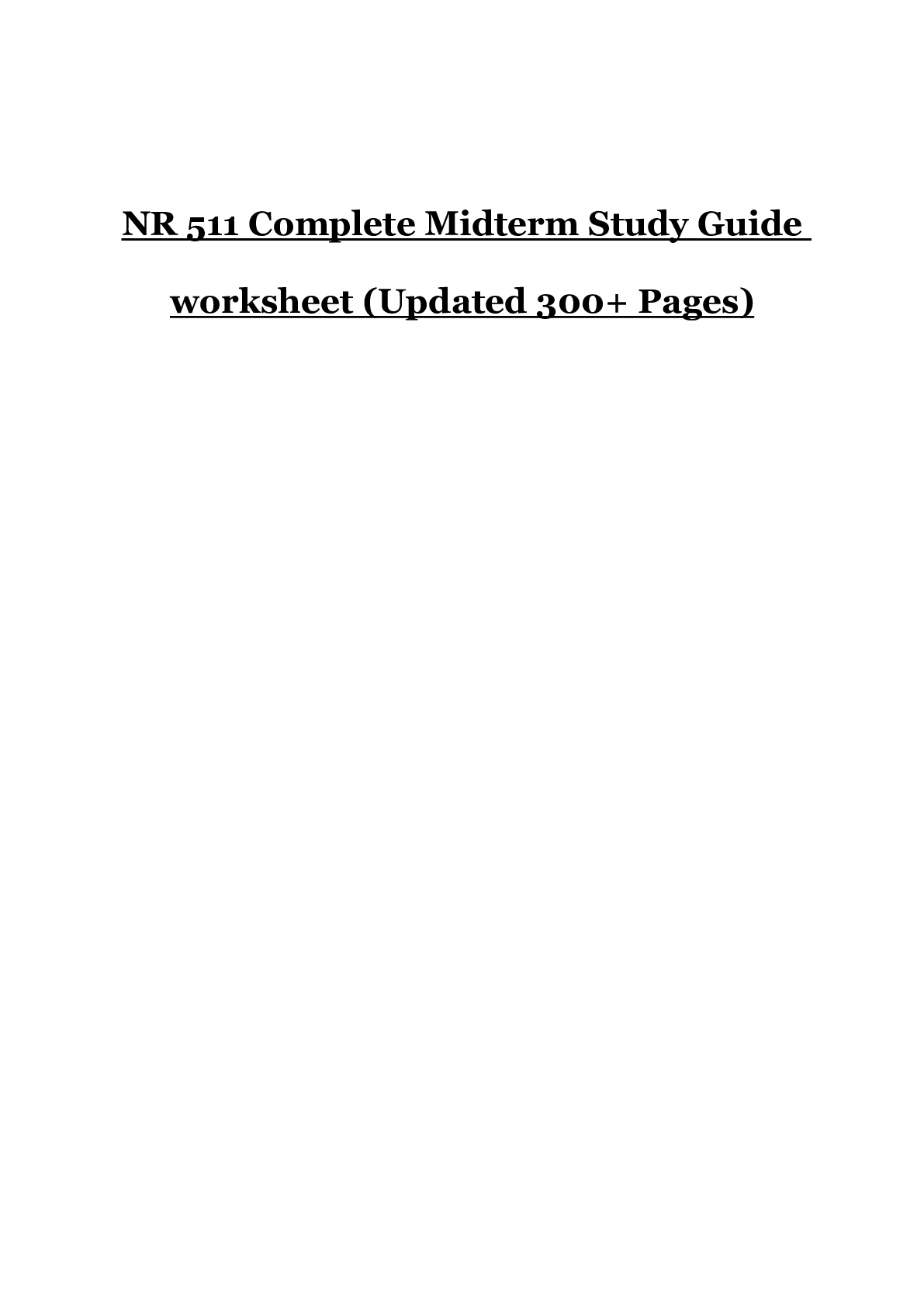
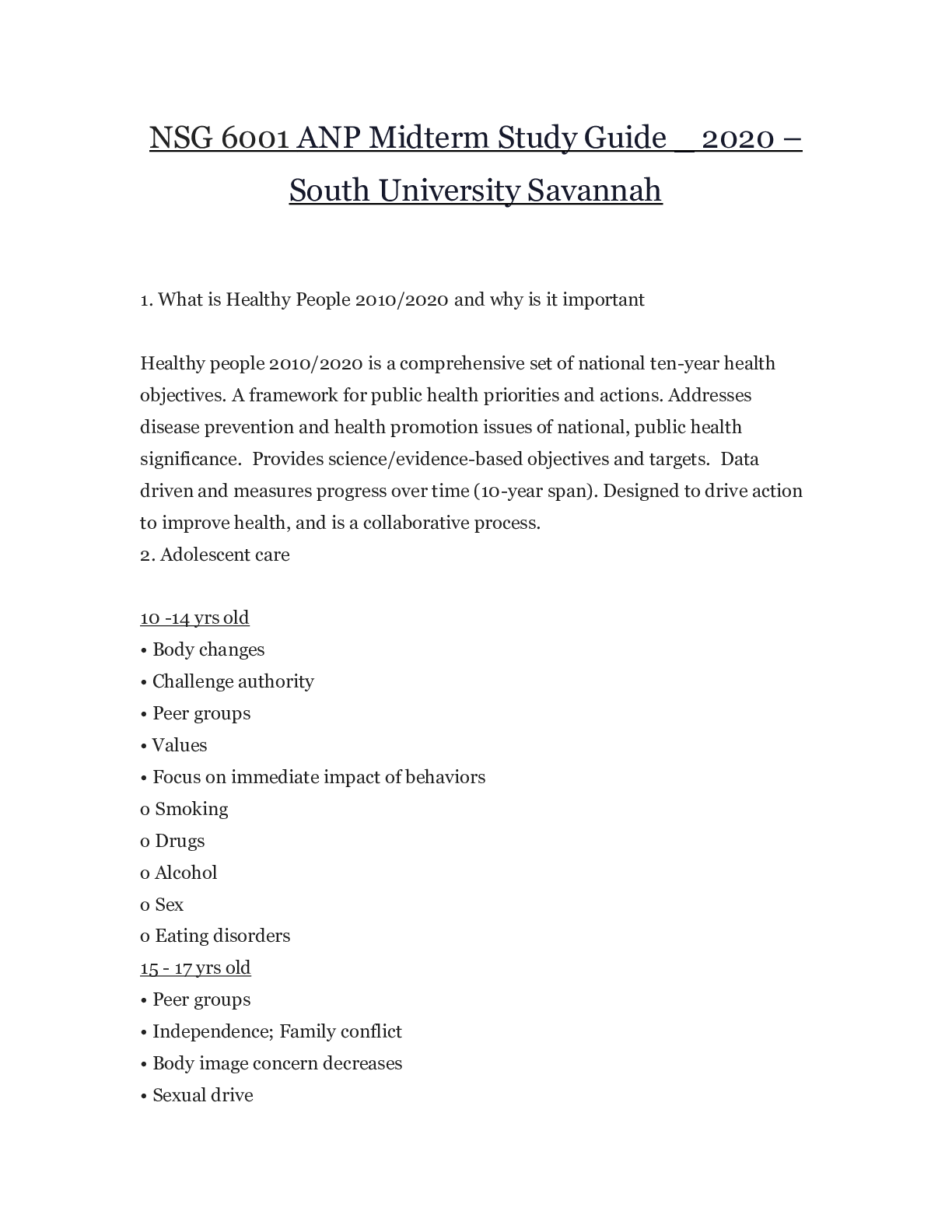
.png)

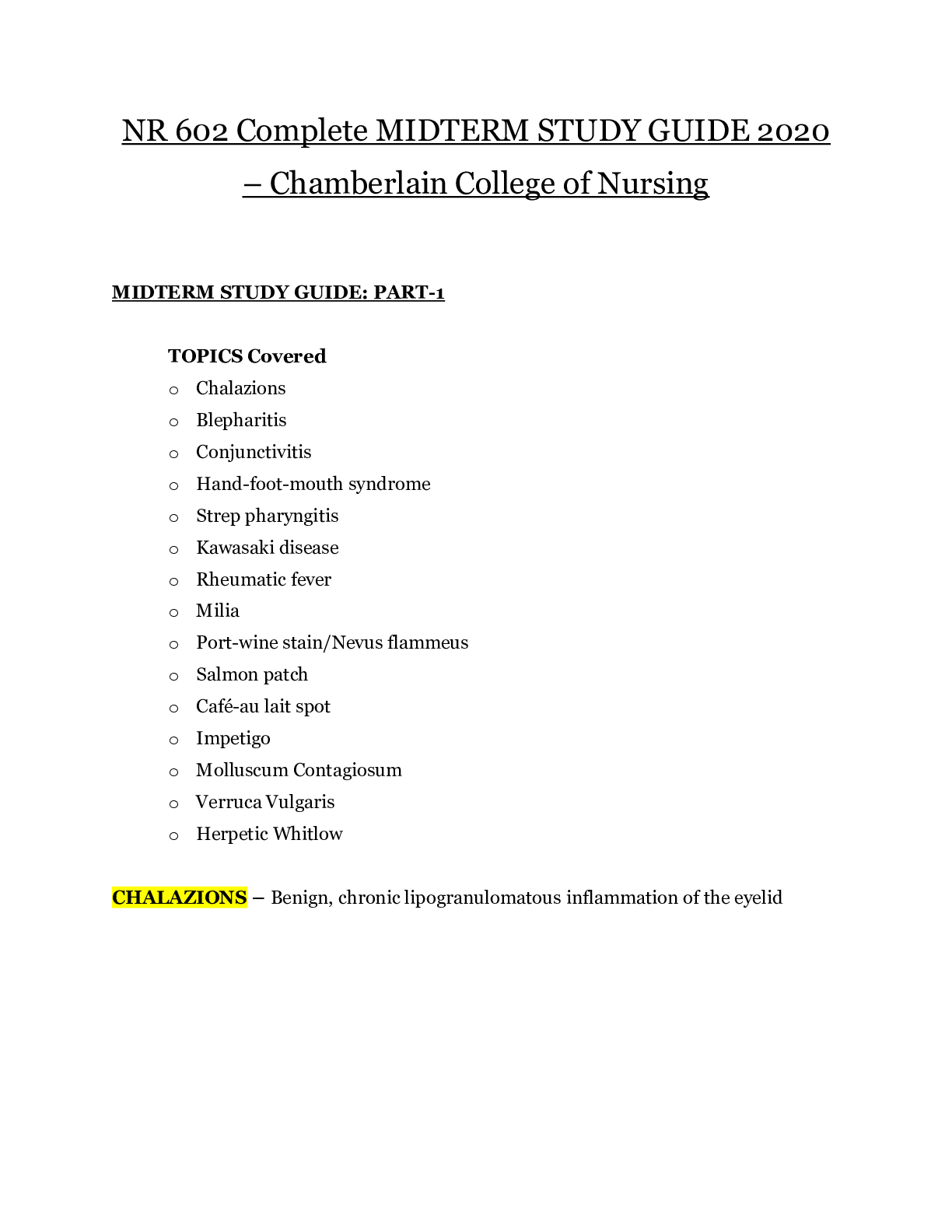
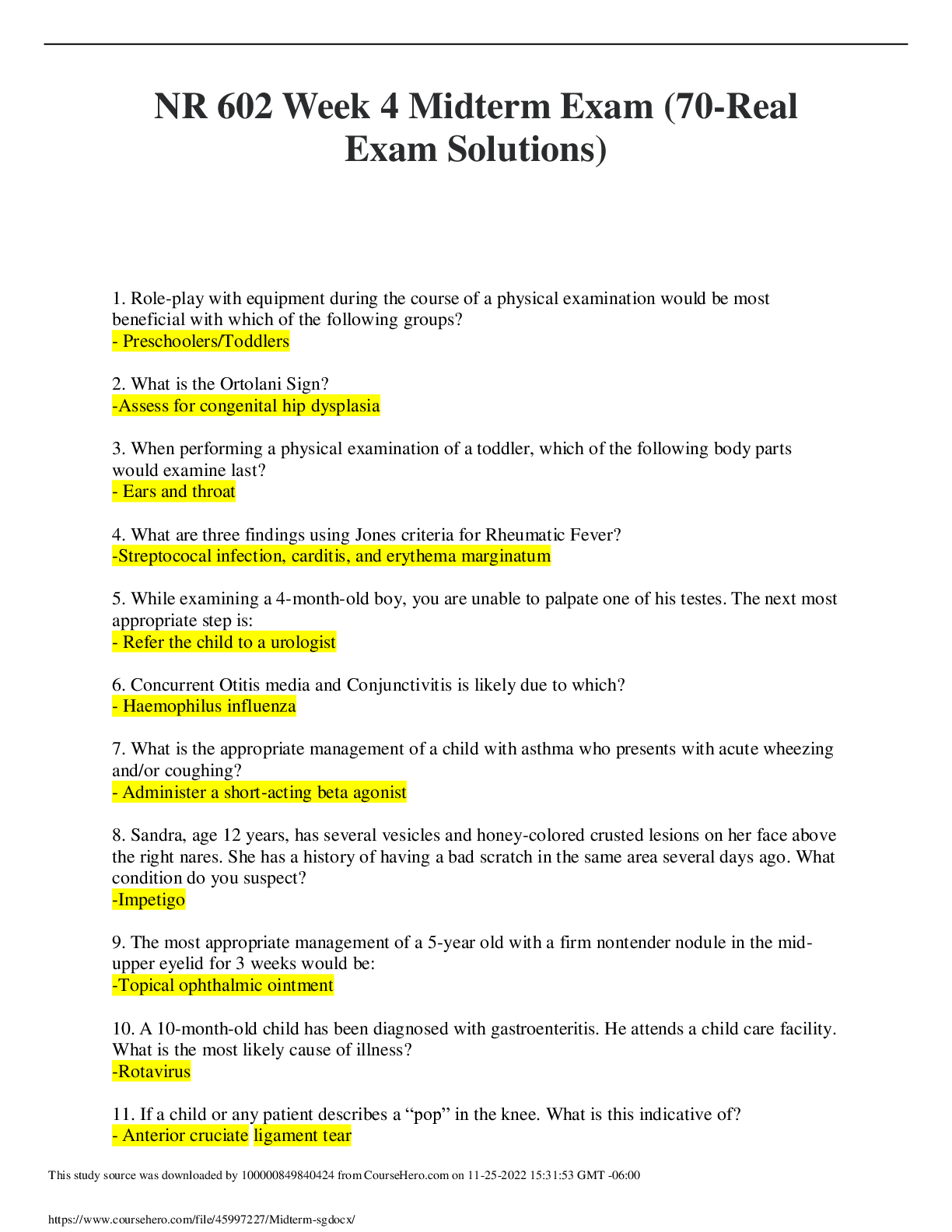
.png)


